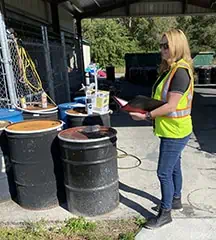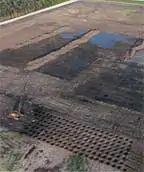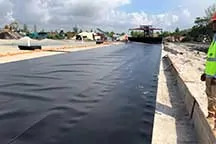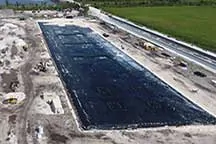

Executing Brownfield Redevelopment
Green spaces are dwindling rapidly as real estate development forges ahead; meanwhile, a plentiful inventory of brownfields lie idle or underused that have great potential to become vibrant, revenue-generating resources.
Well-executed brownfield redevelopment projects make the most of existing infrastructure, leaving green spaces green. They create jobs and increase property values. They improve the health and safety of the environment and people. And turning former liabilities into neighborhood jewels cultivates a spirit of goodwill among residents.
As developers and governments realize the benefits, old gas stations, defunct factories, and closed landfills are among the properties redeveloped into community parks, retail, industrial, or mixed-use properties to become productive assets.
But while communities and private investors can reap tremendous payoffs, successfully repurposing brownfields can be complicated. They may be laden with hazardous substances and other contaminants from past uses, calling for specialized technical expertise to ensure sustainable environmental and financial outcomes.
Meet Amy Guilfoyle
SCS Engineers’ Amy Guilfoyle has been deeply rooted in brownfield redevelopment work for 20 years, supporting plans to ensure projects are technically sound, on time, and on budget.
Groundwater and soil assessment and remediation are her primary focus. Her job involves more than these essential tasks—from helping local governments apply for U.S. EPA Brownfield assessment and cleanup grants and voluntary cleanup state tax credits to ensuring and documenting regulatory compliance.
When Amy was a new biology graduate, she was not sure exactly what career direction she would choose until she got a full taste of fieldwork with an environmental focus.

“I like working on practical solutions to our clients’ day-to-day problems. And I like the creativity involved in finding and developing the best options in each case. Every scenario is unique, challenging you to keep the wheels in your mind turning,” she says.
Guilfoyle’s work typically begins with a Phase I Environmental Assessment, entailing an inspection of the property and a review of documents to evaluate for potentially hazardous pollutants and contamination. She will move on to a Phase II Environmental Assessment, depending on her findings, collecting and analyzing soil and groundwater samples to determine concentrations, locations, and other details to inform what may become her next course. The results help lead her team in developing and executing a rigorous cleanup strategy to meet regulatory standards.
The practiced brownfields veteran has her work cut out for her, especially on her dedicated turf; the state of Florida, whose groundwater and soil quality standards are even more rigorous than the U.S. EPA’s. Guilfoyle must not only stay on top of stringent regulatory demands but know how to strategically approach complex challenges tied to the region’s unique physical conditions.
“For one, as we monitor and plan remediation, we consider soil characteristics. Like much of the Southeast part of the country, Florida is sandy, making it easier for contaminated water and materials to move through the ground than in rocky areas,” she explains.
“Additionally, we give careful thought to the fact that the water table is shallow, which means saturated soil is close to the land surface, increasing the risk for groundwater contamination.”
Protecting groundwater is the most meaningful work she can do in her eyes.
“Keeping groundwater clean is so important to our public health and safety, as it is the major source of drinking water,” Guilfoyle says.
Sizing up cleanup options
In determining the best method to tackle soil and water impacts, she considers multiple variables: regional standards, the proposed use of the property, and clients’ overall goals.
Every success story hinges on protecting human health and the environment while keeping an eye on the bottom line—economics.
“Our clients are taking on huge projects that can have substantial cleanup costs. Our priority is to develop solutions that limit their out-of-pocket costs and liability. But doing it more effectively, so the outcome is a rich resource that serves communities well into the future,” Guilfoyle says.
A solid understanding of regulations is key to delivering sound technical and financially feasible outcomes.
She exemplifies this, beginning with a recent approach involving removing contaminated soil and using the nonimpacted soil as part of a pond construction to expand stormwater holding capacity.
“In this scenario, you save on the cost to transport hundreds of tons of soil and put it to use to build out existing infrastructure. Also, fewer trucks are coming in and out of the site, mitigating a nuisance and greenhouse gases.
“In other scenarios, we have been able to negotiate cleanup levels above the standard by providing documentation to show they are sufficient for full compliance.”
Forging industry relationships through professional engagements
Guilfoyle knows the agencies well through her work at SCS and professional engagements beyond.
Among her involvement, she’s a board member of the Florida Brownfields Association (FBA), supporting educational and outreach efforts and legislative initiatives to secure funding for cleanup projects.
She serves on the Florida Association of Environmental Professionals (FAEP) board, reporting business activity to local chapter members.
She lends her expertise as a board member for Metropolitan Environmental Training Alliance (METRA), promoting free and low-cost training on hazardous waste management requirements and other environmental regulations.
Outside her leadership roles in industry organizations, she finds time for her passion—telling others about the environmental industry. She has been involved with teaching Boy Scouts and Girl Scouts at Science, Technology, Engineering, and Mathematics (STEM) events and introducing college students to job opportunities in these disciplines.
“It’s important to provide a real role model in science and introduce youth to the wide range of job opportunities. We need more sharp young minds. And we especially need more women in environmental sciences,” Guilfoyle says.
“We have done good work. But we have more ahead of us. We will continue making progress by increasing youths’ awareness of what we do and why we do it–and by educating and supporting industry organizations.”
Brownfield Redevelopment Resources, Funding, Careers:
Charles Hostetler, Ph.D., and Kacey Garber join the award-winning SCS Engineers practice serving the region.
As more businesses and municipalities move toward sustainable practices to help protect natural resources, the environmental consulting and contracting firm SCS Engineers is experiencing exponential growth. Most recently, SCS welcomes two professional staff in Peoria, Illinois, with impressive groundwater and wetlands protection backgrounds.
Landfills are required to monitor the underlying groundwater for contamination during their active life and post-closure care period. They operate using modern engineering methods, liquids management systems, and technologies that meet or exceed state and federal compliance. Landfill development may impact existing wetlands or navigable waters of the United States; developing new water resources mitigates or offsets those impacts.
Dr. Charles Hostetler has over two decades of experience as a hydrogeologist planning and overseeing groundwater and wetlands protection programs. His field experience helps solid waste facilities site and run operations safely while proactively monitoring and protecting groundwater and wetland resources. His diverse experience includes developing conceptual designs for the treatment of PFAS in liquid waste streams and sequestration in landfills. You can learn more about Charles Hostetler here.
Ms. Kacey Garber comes to SCS as an experienced hydrogeologist specializing in solid waste management permitting and groundwater monitoring well design and construction projects. Her areas of expertise include groundwater and wetlands monitoring, environmental sampling, hydrogeological site characterizations, groundwater monitoring well design, monitoring well installation oversight, and designing special groundwater studies. You can learn more about Kacey Garber here.
SCS Engineers Business Unit Director Eric Nelson says,
Charles Hostetler, Ph.D., and Kacey Garber bring their landfill permitting and groundwater management expertise to our environmental practice in Illinois. Charles and Kacey share their expertise on the emerging PFAS regulations applied to landfills with our industry at SWANA and NWRA conferences. Garber brings hard-rock geology and groundwater expertise. Her project leadership has been instrumental in removing a Part 807 facility from Post-Closure Care requirements. Hostetler has the distinction of having removed the only Part 811 facility from a Post-Closure Case.
…and your new colleagues say WELCOME TO SCS!
As large tracts of geographically desirable vacant land become scarcer, residential and commercial property developers are increasingly turning to old landfills or former dumps. However, such redevelopment is complex and rife with uncertainties. When compared to greenfield development, the land acquisition costs are lower. Still, any savings are typically offset by greater environmental and infrastructure costs associated with the foundation, landfill gas management, stormwater management, groundwater impacts, meeting closure requirements, and multiple regulatory agency coordination. Therefore, it is important to maximize the developable area while providing engineering solutions to make the project economically feasible. In this blog, we identify some options to reuse challenging sites and lessons learned to contribute to successful redevelopment projects.

Deep Dynamic Compaction
Old landfills or dumps present some unique soil stability challenges. Deep dynamic compaction (DDC) is a ground stabilization technique that has gained popularity in recent years to improve subsurface soil conditions. DDC involves dropping 6 to 30-ton weights from a height between 30 and 75 feet to achieve the desired soil compaction. DDC can effectively apply to a range of subsurface materials, including former C&D debris or municipal solid waste dumps.
DDC provides a stable foundation for future development, minimizes differential settlement while leaving the landfill waste in place, and eliminates the costs associated with removing, transporting, and disposing of buried waste, costing millions of dollars. For simplicity’s sake, let’s consider a 1-acre old landfill or a dumpsite with an average of 15 feet of waste. If excavating the waste and replacing it with clean fill, the disposal fee costs for the excavated waste alone could exceed $400,000. Alternatively, DDC costs range from $1.50 to $2.00 per square foot or $65,000 to $87,120 per acre, excluding mobilization, which costs around $30,000.

Gas Mitigation Systems
Constructing buildings on top of dynamically compacted areas generally requires a combustible gas barrier layer below the building foundation to manage subsurface combustible gases (typically methane). The barrier is required because the waste remains in place. In its simplified form, gas mitigation systems include:

These gas mitigation systems can be either a passive or an active system with a blower. The cost of such systems varies depending on the size of the building, location, and type of liner system used. Typical capital costs for passive systems are in the range of $7 to $9 per square foot for the spray-applied liner and $3 to $4 per square foot for the HDPE liner. For an active system using blowers, add $3 to $4 per square foot. The designer configures a system from these options to address the client’s risk preference and considering future tenant preferences.
Using innovative approaches, impaired lands are increasingly attractive to developers. Beyond the cost-saving benefits to developers realized through DDC and an appropriate gas mitigation system, such projects also create local jobs, increase the tax base, and protect public health and the environment.
About the Authors:

SCS Engineers’ SCSeTools® platform and applications help facilities and companies operate more efficiently by continually gauging operational health and identify trends critical to operations and the environment.
SCS Technology Services®, the technology development practice within SCS Engineers, announces a new application for tracking and analyzing environmental data. The application expands the firm’s SCSeTools® platform, demonstrating its commitment to developing the most advanced data-driven technology in the environmental services industry.
Groundwater monitoring and compliance services are long-term and expensive responsibilities that generate enormous amounts of monitoring and laboratory data. SCS Groundwater™ is a tool to monitor and manage the data associated with operations and reporting requirements for various sites. Sites include active or closed landfills, plants, and impact sites such as former dry cleaners or industrial facilities.
The application also monitors and manages data effectively for clean groundwater applications such as groundwater basin management projects consistent with standard protocol under state and federal environmental compliance rules. SCS Groundwater™ collects and efficiently organizes groundwater monitoring and maintenance data providing those responsible for environmental compliance with a reliable, consistent, and cost-effective way to manage the large volume of information.
The application’s primary value is enabling users to set up a detailed monitoring plan for any number of events, including the sampling points to include and what analyses to perform at each point. Once the information upload is finished, the application checks incoming data against the plan to confirm all work is complete.
SCS Groundwater™ generates reporting components such as data tables, charts, graphs, and maps for compliance, reporting, and finding trends. For example, on a brownfield site, the compliance manager could upload historical monitoring data results, view the data trends over time, and then produce report tables and figures. Operators can also use the data in other applications for additional analysis or visualization.
SCS Engineers’ environmental solutions and technology directly result from our experience and dedication to industries responsible for safeguarding the environment as they deliver services and products. For information about SCS, visit the SCS eTools pages or enjoy our 50th Anniversary video to see the technology in action.
The SCSeTools® platform and applications help facilities operate more efficiently by continually gauging operational health and spot trends that help determine when and how to invest in infrastructure. Field staff, environmental compliance experts, brownfields, developers, and clients in the waste industry guide the technology designs. For additional information and demonstrations of these productivity-enhancing tools, please contact .